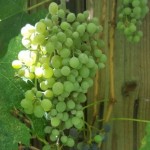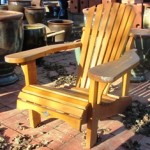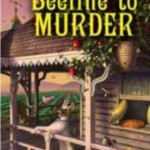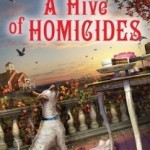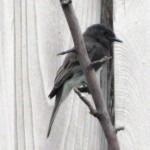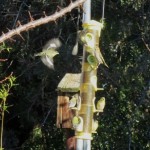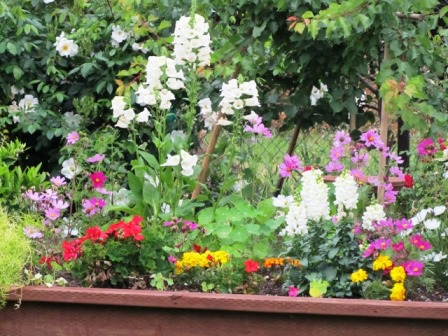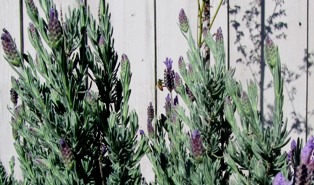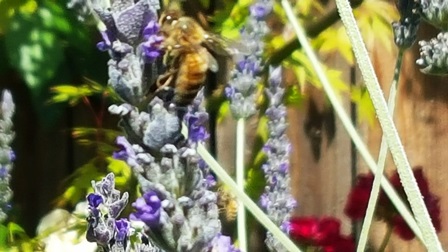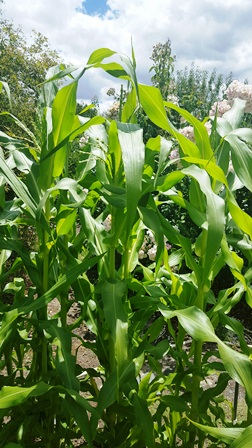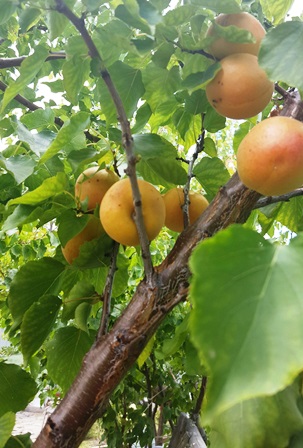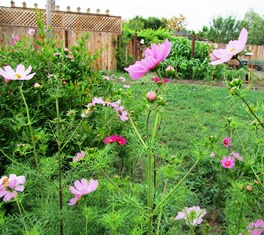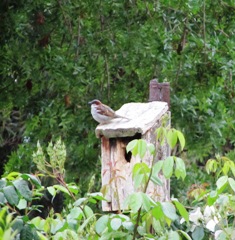Springtime Projects on the Farmette
After weeks of rain, Mother Nature has put on a robe of splendor. Warm weather has arrived. Already, my beekeeper neighbor has had his honeybee hives send out three swarms.
My own bee population seems to be swelling. I’ve fished out my swarm catcher, primed it with scented lemon oil, and placed in among the blossoms in a nearby apricot tree. I may be blessed with a swarm as well.
There are plenty of other springtime projects to attend to here on my farmette. I’ve got to reassemble my temporary grape arbor. Each year, I think we’ll build a permanent structure, but there never seems to be enough time.
My cell flats have organic plants up now and ready for placing in my garden or raised beds. I’d like to add some more chicken manure to the strawberries since they are rapidly growing and producing small fruit.
Other plants need a spring feeding–the citrus, apples, and apricots, for example. I usually do the feeding before the trees break bud, so I’m a little late.
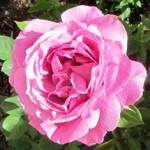
This candy-stripe rose was a gift from a friend–a cutting from her rose that became a large bush in my care
I will be turning the compost pile and mulching all my rose bushes (which have already leafed out and are setting buds). Finally, I’d like to put up a couple more bird houses (mating is already in the air) and fill my hummingbird feeders.
- This–my original flock–was massacred by a wild predator, fox or coyote, last year
I need to purchase baby chicks from the feedstore to start my new flock. Hubby and I will build a new, reinforced chicken run and expand the existing hen house.
Then, there’s the side walkway that needs pavers. Painting of the fences. Building a new porch. Widening the patio…the projects are seemingly endless, but that’s fine. We’ll have a lovely six months (maybe an occasional storm). The dry season is upon us.
And I’m ready for the Adirondack chair…oh, that’s right…we have to build it first!
_________________________________________________________________
If you enjoy reading about farming topics and you love a good cozy mystery, check out my novels from Kensington Publishing–A BEELINE TO MURDER, THE MURDER OF A QUEEN BEE, and A HIVE OF HOMICIDES. All are available on Amazon.com, Barnes & Noble.com, and other online retailers as well as in bookstores everywhere.
How to Attract Birds to Make Your Garden a Sanctuary
A Chinese proverb states that “If I keep a green bough in my heart, then the singing bird will come.” I think I was born with that green bough in my heart because I have always loved birds–and not only the songbirds.
By offering food, water, and safe and dry housing as well as blooms for every season (flowering annuals, perennials, herbs, bulbs, and fruits and berries), I am able to attract many different birds into my garden.When birds are present, especially the songbirds, the garden becomes a special sanctuary.

A hummer’s iridescent feathers shimmer as it perches in sunlight at the end of an apricot tree branch
I hang feeders and fill them with various types of seed and suet cakes as well as syrup for hummingbirds. Food attracts local and migratory birds flying through this time of year. It’s best to choose a wide sampling of foods such as seeds, nuts,hulled sunflower, safflower, Nyjer thistle, peanut, millet, fruit, berries, raisins, and meal worms to draw interesting bird traffic.
Some of the birds we regularly see include scrub jays, wrens, finches, sparrows, red-tail hawks, mockingbirds, quail, mourning doves, robins, barn owls, hummingbirds, and crows.
With food scarce in the wild, the birds visit the hanging and platform feeders. For ground feeders like mourning doves, I put out a large saucer under the apple tree and, yes, I leave a few apples on the tree for the birds to peck. For a list of birds and the types of seed and other foods they consume, see, https://www.wild-bird-watching.com/Bird_Seed.html

Mourning doves mate for life; these two are joined at the feeder by a third who has lost his or her partner
Some of our winged visitors stick around to mate and build nests in climbing rose bushes, brush piles, trees, or one of the many birdhouses we’ve hung. Only the owl basket high in the pepper tree remains empty, but we’ve heard a lot of hooting at night so we’re optimistic that owls will take up residence here. We live close to designated agricultural lands and the empty field behind us has a lot of mice–their favorite food.
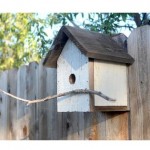
My hubby built this birdhouse from a fence board. Not all birds will take up residence in a house, but many will.
Birds build nests in backyard birdhouses and brush piles as well as in trees, shrubs like climbing roses, and under the protected eaves of buildings (mourning doves especially seem to like these). Hummingbirds will build their tiny cup-like nests in shrubs (we found one in our Cecil Brunner climbing rose bush) and trees, from 10 feet and up in locations where wind isn’t a threat.
A water source is important for attracting birds since they both drink and bathe in the water fountains and bird baths of backyards and gardens.
If you provide food, water, and a safe and dry shelter for the birds to eat, breed, and nest, you will be rewarded for not only the singing birds will come but other interesting species as well.
_______________________________________________________
If you enjoy reading about living close to the earth and a good yarn, check out my Henny Penny Farmette series of cozy mysteries: A BEELINE TO MURDER, THE MURDER OF A QUEEN BEE, and my latest, A HIVE OF HOMICIDES.
These mysteries are chock-full of tips for keeping chickens and bees, growing heirloom fruits and vegetables, and backyard DIY projects. For more information, click on the URL.
A HIVE OF HOMICIDES
How to Attract Hummingbirds to Your Garden
Here on the Henny Penny Farmette, we love watching the spectacular aerial maneuvers of male hummingbirds attempting to attract the interest of a nearby female. These gorgeous feathered flirts know how to bedazzle a potential mate with spectacular maneuvers that show off the intense coloring of their iridescent feathers.
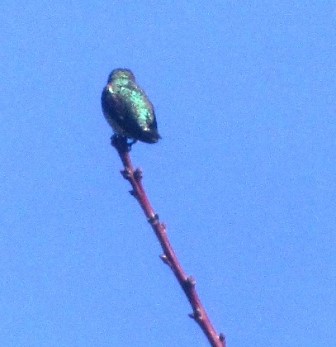
A hummer’s iridescent feathers shimmer as it perches in sunlight at the end of an apricot tree branch
Depending on the species, these tiny birds can flutter their wings in a figure eight pattern (they don’t flap them) from 12 to 80 times per second. All that fluttering requires tremendous energy.

Hummers are attracted by the intense hue of certain flowers such as nasturtiums and the promise of nectar
Hummers mainly get their energy from plants with brightly colored, nectar-rich flowers. They will dine at hummingbird feeders filled with red sugar-water and hung around gardens that feature plants with brightly colored blooms, especially if those blooms are high in nectar. The following is a list of plants known to attract hummingbirds.
- Impatien
- Nasturtium
- Phlox
- Nicotiana (flowering tobacco)
- Salvia (scarlet sage)
- Snapdragon
If you like plants that return each year, tuck in these brightly colored perennials.
Alcea rosea
- Aloe
- Bee Balm
- Columbine
- Coral Bell
- Four-o-clock
- Gladiola
- Penstemon
- Phlox
- Salvia
Shrubs such as the butterfly bush (Buddleia) and the flowering maple, hibiscus, and rosemary hold a special appeal for the hummers. They also will be attracted to blooming vines (especially those with trumpet or tube-shaped flowers in intense colors). Tuck in Cape honeysuckle, flame vine, or the blood-red trumpet creeper and watch the hummers darting in and around these vines from dawn until dusk. For more ideas, visit your local nursery or birding store.
* * *
Do you enjoy reading about farming topics? Check out my cozy mysteries–A BEELINE TO MURDER and also THE MURDER OF A QUEEN BEE (both in the Henny Penny Farmette series from Kensington Publishing).
My farm-based novels feature delicious recipes, farming tips, chicken and beekeeping tips, sayings and, of course, a charming cozy mystery. For more info, click on the links under the pictures.
The books are available through online retailers such as Amazon, Barnes & Noble, Target, BAM, Kobo Books, and Walmart as well as from traditional bookstores everywhere.
See, http://tinyurl.com/hxy3s8q
A Beeline to Murder is the debut novel that launched the Henny Penny Farmette series of mysteries. Initially released as a hardcover novel and in e-book format, it is now available as a mass market paperback.
See, http://tinyurl.com/h4kou4g
NEWLY RELEASED! This, the second cozy mystery in the Henny Penny Farmette series, is garnering great reviews from readers and industry publications.
How to Attract Local Pollinators
Today, I spotted a gorgeous bee, big and black with reddish-brown wings, dipping its proboscis into the lavender wisteria and other blooms in my garden. I was stung by a bee yesterday, but that doesn’t stop me from smiling with delight observing this little pollinator at work in my garden.
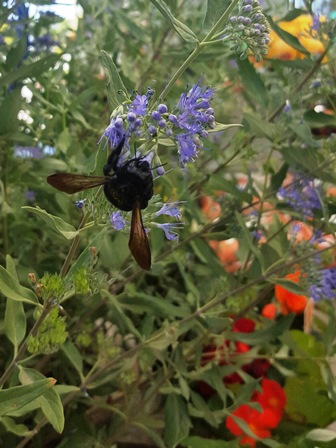
This longhorn bee, twice the size of a honeybee, dips its proboscis (meaning, tongue, nozzle, or snoot) into a bloom.
I admit I’m a fan of pollinators and enjoy watching them work amid the sunflowers, zinnias, cosmos, wisteria, and other blooms in the bee and butterfly garden I planted earlier this year.
The flowers attract hummingbirds, butterflies, bumblebees, and other types of bees, including my own Italian honeybees, the stock of bees most favored in this country (Apis mellifera ligustica). See, http://beesource.com/resources/usda/the-different-types-of-honey-bees/
Honeybees pollinate 90 percent of North America’s commercially produced crops, including almonds. That’s why many Northern California almond growers rent honeybees for use in their orchards during springtime bloom.
The National Academy of Sciences has noted that pollinators are needed to reproduce 75 percent of the Earth’s flowering plants. But there’s been a drop in natural pollinators, in part due to habitat loss and pesticide use.
Populations of the yellow, black, and brown Western bumblebee, once common from southern British Columbia to central California, have now all but disappeared. To attract bumblebees, plant giant hyssop, milk weed, and nettle-leaf horse mint. See, http://www.wildflower.org/collections/collection.php?collection=xerces_bumble
Here’s what else we gardeners and farmers can do to attract local pollinators.
1. Avoid using pesticides.
2. Plant bee, bird, and butterfly friendly native plants.
3. Choose plants that flower in varying diverse colors and shapes to attract a wide variety of pollinators.
* * *
If you enjoy reading about farmette topics (including gardening, beekeeping, and delicious recipes), check out my cozy mysteries A BEELINE TO MURDER and also THE MURDER OF A QUEEN BEE in the Henny Penny Farmette series (from Kensington Publishing).
These novels are available through online retailers such as Amazon, Barnes & Noble, Kobo Books, and Walmart as well as from traditional bookstores everywhere.
See, http://tinyurl.com/hxy3s8q
Now available in mass market paperback, this debut novel launched the Henny Penny Farmette series of mysteries and sold out its first press run.
See, http://tinyurl.com/h4kou4g
The second cozy mystery in the Henny Penny Farmette series, available Sept. 27, 2016
Time Spent in a Potager Garden Renews the Spirit
With the official start of summer a few days away, I find myself leaving my computer and the scene I’m writing on my third novel to take a break in the garden. Alive with honeybees, bumblebees, butterflies, and hummingbirds, the garden is perfect place for a respite and a cup of tea.
Quite like a potager garden that includes flowers, herbs, trees, vegetables, berries, and grapes, mine also includes a patch of corn.
Embroidered around the edges of the garden, there are climbing roses, fruit trees, and lots of lavender. Along the rows of lavender, there are peach trees with fruit the size of softballs and five pomegranate trees, laden with blooms and new fruit.
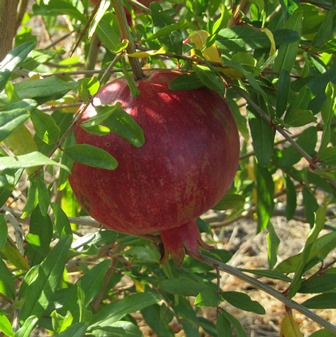
The pomegranates aren’t quite this large yet, but the trees have so much fruit, they’ll have to be thinned.
As I meander, I discover the trees of red and yellow plums have begun to drop their ripe fruit. I’ve got to make those plums into jelly or jam and ditto on the apricots.
But that work will have to wait until my late afternoon tea break. My novel won’t write itself. Still, the time I spend in the garden revitalizes my spirit and refreshes my brain cells, enabling me to return to the computer and the scene I’m writing with renewed vision and vigor.
* * *
If you enjoy reading about gardening, keeping bees, raising chickens, and creating delicious recipes, check out my novels from Kensington Publishing.
The Henny Penny Farmette series of cozy mysteries are available at Amazon, Barnes and Noble, Kobo Books, Walmart, and other online and traditional bookstores everywhere. Available in hardcover, Kindle, and mass market paperback formats.
Plants to Attract Hummingbirds
It’s hummingbird mating season. We’re seeing iridescent males with ruby throats engaged in amazing aerobatic flight patterns to attract females. To draw these birds to our garden, we’ve put in plants they are known to seek out.
To attract them, we’ve planted flowers with brightly colored blooms such as purple-spired agastache, red blooming wild columbine, cosmos (pink, white, and red) scarlet ipomopsis (also known as the hummingbird plant), larkspur (Giant Imperial has colors ranging from pink, dark blue, light blue, carmine, rose, salmon, and white), lobelia (various shades), poppies, and salvia (Fairy Queen has a brilliant purple color).
This morning as I was inspecting the peach tree, a male with a ruby throat perched on a branch right above the branch tip I was holding. I love seeing these little birds who are voracious feeders, consuming daily nearly half their body weight in nectar and feeding from the sugar-water feeders I’ve hung near my kitchen garden window six to eight times an hour.
Many of the above-mentioned plants also attract butterflies. Sow a few of each of these seeds and you’ll have visitors to your garden throughout the spring and summer months (or during each plant’s blooming season).
Letting Gardens Dry Up Is Hard On the Honeybees
My neighbor, a world-class beekeeper whose honey sells to many specialty markets and also Whole Foods, told me today honeybees in backyard hives in our East Bay communities are hungry. He has put out two five-gallon cans of sugar water to feed his bees.
Interestingly, I’ve noted bees at my hummingbird feeders also usurping the sugar water meant for the hummingbirds.
The honeybees do not make honey from sugar water. They just consume it to have energy to forage for pollen and to cool the hives on hot days. The drought means people are watering less; flower gardens and local landscape are dry, and in places the clay soil is cracking open. Bad news for bees.
Weatherwise, it’s been triple-digit hot and then cold and cloudy. I guess the bees will adapt but old timers say, “A swarm in July means bees go bye-bye.” This isn’t the right time for swarming.
My hived bees are loud and energetic. The bees faked me out with a small swarm about ten days ago and then returned to the hive; and now they are eating sugar water for energy to gather what pollen they can find to make honey. The honey will see the hungry hive through until the star thistle and the fall eucalyptus blooms. I’m torn between letting my bee-loving flowers dry up to conserve water, but I don’t want to lose my bees.
Is He or Isn’t He a Brown-headed Nuthatch?
I’ve been checking out the photos of birds I’ve taken since moving to the Henny Penny Farmette. I’ve been able to identify most of them, but one took a while for me to figure out. Like other birds that come by for a visit, he perched for a spell atop the rough-hewn birdhouse on the back fence. I think he is a brown-headed nuthatch (sitta pusilla), although I am not completely convinced I’m right. Half the fun of being a bird watcher is figuring out what species you have spotted.
Still, the bird has the right markings–the brown cap down to the eye, white nape spot, white throat and underparts, and some gray on its back. With beady eyes, broad shoulders, and a short neck, this little bird seems to best fit the description of the brown-headed nuthatch although that species likes the pine forests of the southern United States and travels in flocks. This fellow showed up alone in my Northern California garden.
I got out my Audubon Society bird guidebook and the Song and Garden Birds of North America, a National Geographic book, to help me identify the nuthatch and some of our other feathered friends. So far, we’ve had visits by sparrows, finches, scrub jays, a pair of Western bluebirds, mourning doves, wrens, a barn owl, lots of hawks and crows, and hummingbirds.
We’ve put up birdhouses, some with rough bark exteriors, that seem to attract certain types of birds. Other birdhouses are smooth surfaced. The bluebirds were checking out one of those today. Spring will come . . . eventually, but even before trees start to break bud, the birds will be scouting nesting sites. I’m hoping the brown-headed nuthatch will return with a mate and stay around for a while.
 Facebook
Facebook Goodreads
Goodreads LinkedIn
LinkedIn Meera Lester
Meera Lester Twitter
Twitter




